|
Apr
30 |
Comic
Review4 - Umimachi Diary - |
|
 I'd like to introduce Akimi Yoshida, one of my most favorite comic artists this time.
She made her debut around '80 and has been producing many splendid stories one by one since then. A lot of popular comic artists tend to work on some stories simultaneously but she doesn't do that. I'd like to introduce Akimi Yoshida, one of my most favorite comic artists this time.
She made her debut around '80 and has been producing many splendid stories one by one since then. A lot of popular comic artists tend to work on some stories simultaneously but she doesn't do that.
Especially, after publishing "California Story", she's been recognized for her own unique and characteristic style, which is very serious just like a literary work but also contains loveliness and humor as well.
Her pictures are rather simple and her stories are sometimes very hard for girl's comics. Still she also has this lyrical sense from the start. All in all, her works are always very unique, so no one can imitate her style.
Well, today's theme is her "Umimachi Diary", means "Seaside City Diary".
The story progresses in Kamakura, the city alongside the Shounan beach.
Kamakura is known as a very stylish city nowadays but also an old one which has a very long history.
In the picture above, the girl is Suzu and the boy is Foota. They are two of main characters.
See Foota has a miniature of daibutsu, means "big Buddha", which is the symbol of Kamakura.
As it is very famous, many people come to the city to see it.
Suzu and Foota are the junior high school students and live in this old but stylish city now.
But Suzu lived in the countryside before she came to Kamakura after her father's death.
Before Suzu's father died, her mother had already gone, too. As Suzu's mother was his second wife, she has three half elder sisters whom she had not yet met until he died. Those three sisters live in Kamakura.
Suzu's father remarried after her mother died but his third wife was a very dull woman. Suzu didn't like her. The three sisters came to their father's funeral and met Suzu for the first time. After they noticed the situation their half sister in, they offered Suzu to come with them and live in Kamakura. Suzu decided to go with them on the instant because she couldn't bear her father's third wife anymore. Moreover Suzu seemed to feel sympathy with her sisters. Maybe that was their common warm feelings for their father. Suzu came to Kamakura in this way. Then she met new friends including Foota.
This is, in a sense, a lyrical family drama. But not common and boring as many of them.
The difference depends on the author's viewpoint which is sometimes severe and strict.
Akimi does not avoid depicting the reality of human beings, human nature. This is not love-love kind of irresponsible family drama which is boring and hypocritical. It seems that the author herself dislike hypocrisy. Yet, she also depicts the virtue of human beings. The importance of real love always expresses in her stories. That is because I admire her work all the time.
The following pictures are on the cover of the books. I think that you can feel the atmosphere of Kamakura and Suzu's daily life surroundings. The bitter-sweet story goes on in this old but stylish seaside city. Just feel the wind there.



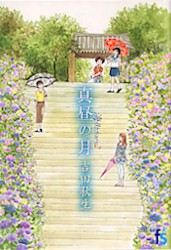
Well, this is certainly one side of Akimi Yoshida. But she has another side which expresses in other works clearly. I'll talk about that next time through her big hit called "Banana Fish". You will see why I said that her viewpoint is different from the authors who can write only hypocritical stories. Just wait and see.
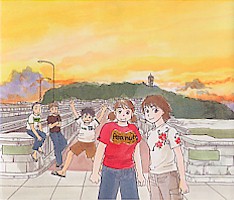
Suzu and her best friend Miho, with their fellow boys behind.
They're on a soccer team.
Categories:
books/comics
|
|
|
Mar
6 |
Comic Review3 - Quo Vadis - |
|
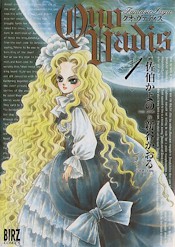
Today, I introduce two of my favorite comic artists who are very famous since 80s'. One is Kaoru Shintani and the other is his wife Kayono Saeki. Both of them are very prominent comic artists but in this "Quo Vadis" Shintani writes the story, Kayono takes charge of drawing pictures. The publisher says that this is a dreamy collaboration, which is true I think.
Shintani created many interesting stories in the past. I know most of them and always admiring his knowledge over many different fields. I think he is one of the most diligent and hardworking person in the Japanese comic world.
Take "Area 88" for instance. The background of this story is the warfare in the Middle East. A Japanese boy named Shin was caught up in the war as a fighter pilot because of a betrayal of his best friend. No one can write a story like this without a broad knowledge about the international situation. That is also expressed in "Desert Rose". The heroine is a beautiful woman named Mariko Rosebank who lost her little boy when an airport was bombed by terrorists. An ordinary housewife became a woman fighter against terrorists for revenge.
The two stories are very brave but Shintani made his debut as a comic artist in the world of girls' comics first. In those days, not only girls but also boys are enthusiastic about girls' comics because, as I said before, the girls' comics are highly refined and intelligent than comics in other categories. So girls' comics were no longer only for girls and gradually the limit was removed then. The works like "Area 88" or "Desert Rose" were born in this situation. Those themes and stories are fundamentally for boys but girls like me also love them. Shintani's works contain many elements which are attractive for both boys and girls.
And his thoughts reached "Quo Vadis" now.
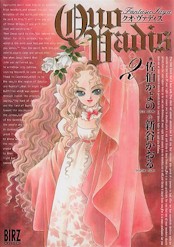 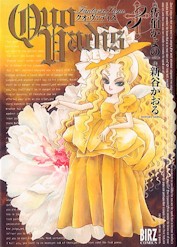
Before I write about the story itself, I want to introduce Kayono Saeki, too. See the pictures on the title. Those are undoubtedly and unarguably beautiful, aren't they? The little girl in the picture is Freyja who is the heroine of this story. She is also called "professor". Why? I'll tell about it later. Anyway this is the typical Kayono Saeki type of beautiful girl. No one can create this kind of divine character except for her.
One of my favorite works by Kayono is "Akihi". Akihi is the name of the heroine who is still 17 years old but a prominent art dealer. She's been searching for a painting which painted by her father long ago. Her mother went away for her former lover when she was a child and her father already died. So the picture in which Akihe was painted is the only relic and memory of her happy days with her father.
The story is emotional but even in this kind of work her husband's broad knowledge is alive which makes the story more complicated and interesting. I think all the pieces which they create are their collaboration in a sense. There is no other example like this as long as I know.
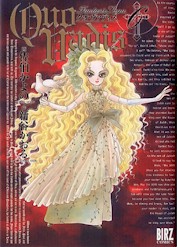
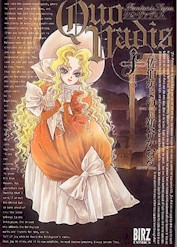
Well, now I talk about the outline of the story "Quo Vadis".
Odin who is a handsome antiques dealer looks around 30 years old but he lives over 8000 years in reality. He's been searching for his colleagues who jumped into the past with him from the future for so many years.
In the world which he was born, all the things reached a limit. The human being itself reached the limit as a race and the world is almost coming to an end. People look like leading a happy life but without love. The totally controlled world is there. The result of repeated gene control bore people like Odin who cannot die and live almost forever.
Professor Freyja was one of the people who were worry about and afraid of the cul-de-sac situation. So she plotted a plan to find the divergent point in history. Finding out the point and amend or correct it is the only way to change the situation they're in. So she and her followers including Odin needed to jump into the past. But the accident happened then and they were separated in the sea of history.
After 8000 years of woe, Odin found Freyja at last. She was a grownup woman when they parted but after so many years, for what reason, she became a little girl. Still Freyja is Freyja, intelligent and brisk but her appearance is so lovely that she looks like a tomboy now. Her beauty and loveliness is one of the big charms in this work.
They began to search for other members who time-jumped with them but it was nearly an impossible work. Moreover the days Odin lived in the past made the situation very complicated. Because one of his colleagues named Joshua who died 2000 years ago left a big problem.
Sorry but I think you should find out what is the problem in the book and whether they can accomplish their purpose or not is still unclear. Because the story is on the way now.
Anyway, the stories which Shintani and Kayono create are always very entertaining. Try not only Quo Vadis but also the other works if you have a chance.
Categories:
books/comics
|
|
|
Feb
11 |
Comic Review2 - Tableau Gate - |
|
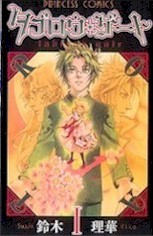 There are many splendid comic books which aren’t translated into English
or other languages yet. Today I introduce one of them. The title is
Tableau Gate by Rika Suzuki.
There are many splendid comic books which aren’t translated into English
or other languages yet. Today I introduce one of them. The title is
Tableau Gate by Rika Suzuki.
As I wrote in Comic Review 1, the Japanese comic world has been in the
mess since 90's and not many talented people come out. Most of my
favorite comic artists have been active since 80's but the artist of
this book is one of rare exception. See the pictures on the cover!
Beautiful, aren't they?
Rika is originally an illustrator, she claims so even after her big
success as a comic artist. She visited a publisher named Kadokawa
Shoten to sell her illustrations at first. But the editor who saw
her works suggested to her to create a comic. So the Tableau Gate was
born.
But as I said the Japanese comic world is no longer flourishing,
publishers tend to give up the publication of comic magazines these
days. The magazine which Tableau Gate was on was one of them. The story
was also stopped with it and the artist engaged in other works for 7
years until Tableau Gate was resumed.
The way how the story was resumed is also a story. The editor who
suggested to Rika to create a comic moved to other publisher named Akita
Shoten. It is one of the oldest publishers which publish comic books
mainly. The editor wanted Tableau Gate back on the road again there.
Easy to say, but as the story was once published by other company, it is
very difficult to republish it from a different one, especially in this
case. It's true that many other stories were stopped when the magazine
was closed and have been dead since then. But with the editor's strong
effort, the story was able to move to another company and rebirthed
as a bland new version.
I want to say that it's in reality a "rebirth". The main characters are
mostly same but the story was refreshed and that is much better than
before. Moreover the drawing skill of the artist was greatly improved
and say, no one can complain about the beauty of it. Rika says it's
owing to the editor and the readers who had been waiting for so long.
The gratitude of the artist clearly expresses in the pictures. I think
the beauty of it is the artist's pure feelings for her story and her
readers.
 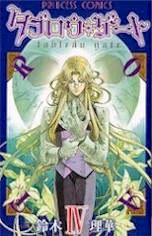
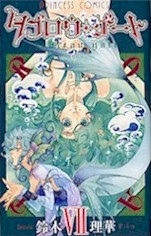
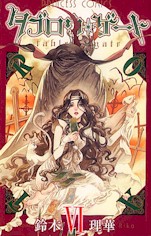
Well, now I write about the outline.
There is a boy named Satsuki who lost his mother long ago and do not
know who his father is. He only has his grandfather who is strict and
severe, always hard on his grandson. The reason is not only because
Satsuki is his successor and the one who inherits his big fortune but
also Satsuki resembles to his father very much. The grandfather loved
his daughter strongly, so he thinks Satsuki's father plundered her
unfairly.
Satsuki was disowned and expelled from the marvellous residence in
England at last and moved to Tatehama city in Japan. The house he moved
into was also luxurious but the boy lives alone and lonely. Satsuki
feels he is a trash and the empty big house is a dump.
But one day he received a package. It was a book called "tablet", which
is the origin of the disturbance after that. He received it and opened
it, so something strange came out of the book and flew away. While he
wondered what was happened, a little girl named Lady jumped into the
house through the window. She said she had been searching for the book
and reached here all the way from England. Knowing that Satsuki broke
the seal and released the tableaus, she got very angry.
What are tableaus? Those are something like spirits or fays which have a
special power respectively. They obey the orders of their master who
knows their names. Lady was the master until she lost the book but once
they ran away, she has to make them approve her as their master and tell
their names to her again. But getting back the tableaus is not an easy
work. Some want freedom and there is one who wants to be the master
himself. Lady ordered Satsuki to help her recover them. As she decided
to live in the house until all the tableaus come back, now he has one to
live with, which is a good thing for him. And as the tableaus come back
one by one, they become his family.
As the 22 tarot cards are the themes, there are 22 pages in the book. A
tableau lives in each page. So 22 tableaus must be there but most of
them are no longer in the book. Getting back them is the adventure of
Satsuki and the girl Lady.
**************
I'd like to talk more about the story but it is too long to be a blog
entry. So the main reason why I recommend it will be on here in the mean
time. Anyway full of love and messages from the artist are in Tableau
Gate and there is also a very interesting philosophical background. It's
OK to enjoy it as a fantasy but it's also enjoyable to find out a
profound meaning of a good story. That is the real Japanese comic.
Categories:
books/comics
|
|
|
Jan
11 |
Comic Review1 - Tetsusabi Haien - |
|
Certain Japanese comics are not only for entertainment. First of all,
why do you think that so called the comic generation in 80's existed in
Japan? Why Japanese youngsters were so enthusiastic about comics in
those days?
That's because Japanese comics are/were Pop Art like British Pop/Rock
music in 70's to 80's were Pop Art. I mean, as you know, fine Pop/Rock
artists in U.K. have their own thoughts. So Japanese fine comic artists
are/were the same. On the contrary, very interesting that most of the
Japanese self-claimed (modern polite) literature have no or just
low level philosophical background. At most Mishima who died in the
strange way.
But Japanese fine comic books sometimes contain very profound
philosophical thoughts. Take Jun Mihara for instance, who died years ago
but her influence is still alive.
Don't take "Nana" or "Hana yori dango" type
of comics from 90's. Those are only for entertainment. Typical mere
comics for children or people who don't think anything, not Pop Art.
However in 80's, Jun Mihara brought philosophical thoughts into her
story. Not only her but also a lot of splendid comic artists have their
own views and brought them into their pieces. So those were already not
for children, but for intelligent and idealistic youngsters.
Well, after that, since 90's, the Japanese comic world has been in the
mess. Almost no more new Mihara or philosophical backgrounds any more.
Alas! Most of them are for thoughtless children. Still, thank god, as I
said "(people like) Mihara's influence is still alive", some comic
artists are "artists". So I still love comics.
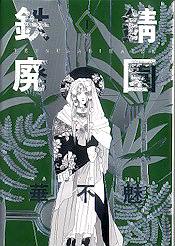 Today I'd like to introduce one of them.
Today I'd like to introduce one of them.
The title is "Tetsusabi Haien", literally means "Iron Rust
Waste Garden" but I think "The Rusted Paradise" is better from the
story. This is by Kazumi who made her debut to the Japanese comic world
in 1989, but stopped her career because of her bad mental / physical
conditions. So "Tetsusabi Haien" had been unfinished until
2009. The beginning part of the story was published in 1991 first, so
the blank is almost 20 years. After so many years, she came back and
completed the story in 2009.
Times are changing fast, but good stories contain eternity. The fact
that many fans awaited its comeout tells how the story goes. Moreover
the new complete version of books are published with luxurious binding.
Though not hard cover, the papers are fine for comic books and the cover
is printed with shiny colours of gold and silver. Those are a bit
expensive but, think of the years, worth it.
The story is a fantasy with the artist's own views of the world. Once
there was "the Magna Disaster", when a devilish magician
named Isa Mel (sorry, the spell is vague) opened the route from the
monsters' dimension to the world, so thousands of monsters rushed in.
The result was disastrous. Angels, magicians, and fighters died during
the long fierce fight to close the route, but at last Isa Mel was locked
into a stone and the route was closed. But many survived monsters are
still alive and wanting this fertile world. So after 600 years of woe,
they plundered the stone which Isa Mel was locked in and made him come
back to life. So again the war has begun.
In the mean time, there is an eminent magician called Gelsomina. But his
real name is Sodai whom revived Isa Mel desperately wants to get back.
It seems that there was some discord between Isa Mel and Sodai more than
600 years ago and the secret, as well as the reason why Isa Mel wanted /
still wants to destroy the whole world, is hidden in the ancient history.
Alongside of this main stream, there goes some side stories at the same
time all in one. Like who loves who or who wants what. Through those, if
you have an eye for art, you can see how the artist sees the world and
what kind of thoughts she has.
In addition to the story which is mainly serious but sometimes funny,
the pictures are very splendid and full of originality. Not only Isa Mel
and Sodai, but other boys and girls in the story are mostly beautiful,
which one of the fascinating factors of "girls' comics". (Kazumi
persists in claiming her pieces are "girls' comics". I think it
reasonable because "girls' comics" in 80's were the origin of the comic
generation which Kazumi herself was influenced. Different from boys' or
ladies' comics, only "girls' comics" can/could exist as art pieces
because of its highly refined sensitivity. At least in 80's, if I may
say so.)
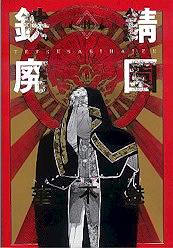
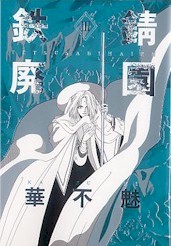

By the way, there's another unfinished story by Kazumi titled "Glamorous
Gossip". This is rather a space fiction type of story than a fantasy. I
encountered "GG" in 90's and that was the first time when I read her
comic. "Tetsusabi Haien" is a good one but even more than
that I like "GG". Like "Tetsusabi", "Glamorous
Gossip" is now resumed to complete and you can read the latest
continuation at "Web
Magazine Wings" for free. If you're good at Japanese, try it or the
book "Tetsusabi Haien". So you can see why I said that
"certain Japanese comics are not only for entertainment".
Categories:
books/comics
|
|
|

To see all the entries in this site.














|